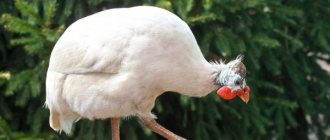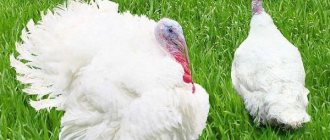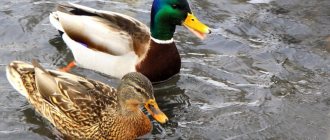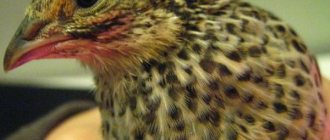Main Differences
Over many years of work on breed selection and breeding of geese, several popular methods for determining differences between the sexes have emerged. Each of them has its pros and cons, but together they give excellent results. There are also tips on how to distinguish a male from a female by appearance.
Appearance
External signs will definitely appear sooner or later. The surest external sign is the growth of the gander. Even with the same weight, it will be significantly taller than a goose. The male also has a stronger body and a confident gait. The gander's head is larger and its neck is longer.
Often the male beak is less powerful and has a hump, while the female half has a straight or slightly concave beak
However, it is not always possible to determine the sex of birds by appearance, so it is recommended to pay attention to the habits and character
Character and behavior
The character and temperament of geese differs significantly. While geese behave more calmly, quietly and non-aggressively, noisy males try to sort things out and fight for leadership. Anyone who has met a flock of geese in person has seen that the ganders react violently to any obstacle or irritant, hissing and trying to pounce. This is how they protect their females. Also, with any threat or alarm, ganders stretch their necks, while geese, on the contrary, try to draw them in deeper.
At a later stage, during the mating season, the initiative also belongs to the gander: he stretches his neck and tilts his head, and then imitates building a nest. The female only repeats his actions.
How many geese and geese should there be in a flock?
The need to regulate the number of males and females in a flock depends on what goals you are pursuing. If you plan to obtain a large number of eggs and breed birds, then there should be more females than males. Their approximate ratio is one to three. Moreover, the male must be the largest and healthiest. If you keep a bird for the purpose of obtaining meat, then the flock should be formed from the majority of males, since they gain weight better and grow larger than females.
Therefore, determining the sex of geese is extremely important. All the described methods have their pros and cons. Therefore, which one to choose depends only on your skills and knowledge.
Advice from experienced farmers
"Bungee" is a favorite way to distinguish chicks of the most tender age.
How to determine the sex of a gosling using this method:
- The gosling is turned over with its paws up.
- They carefully lift and lower it by its paws, allowing the vestibular apparatus to express itself. It is necessary to create a free fall effect.
- The male will stretch his beak upward, trying to escape from the hands of the person.
- The female goose will flap her head, but will not pull it up.
The shade of plumage can tell a lot to the attentive birder. Even among completely white geese (Kholmogory breed) there are differences between males and females. Thus, ganders always have a noticeable yellowish tone to their plumage, and geese have a grayish tone. Similar differences can be found in geese of other breeds, if you look closely.
The head sizes of birds also vary greatly. Already at 1 month, the gander has a massive head and always has a threatening appearance. The goose is more refined, gentle, there is no aggression in it. The gander's beak is rough, large, and has a dirty tint, even black.
This is interesting: the beak is a characteristic gender characteristic that, in the process of evolution, demonstrated the superiority of the leader over competing males. Geese do not need to fight for leadership, so their beak is much more modest in size.
When mating season begins in the flock, the behavior of the birds changes seriously. Males fight each other for available females. They are very difficult to get along with at this time. Fights occur with enviable regularity and great intensity of passions. The ganders do not need a reason; they are ready to pinch each other, push, pull out feathers at any moment; they are easy to recognize.
Obviously, there are reliable methods for determining the sex of geese and every bird owner can choose the appropriate method. The main thing is to separate the goslings by gender as early as possible. Because if you leave too many ganders in the herd, then when the mating season approaches, you can face serious problems. At the same time, a herd of only females will never produce offspring. Knowing how to determine the sex of a gosling, the poultry farmer can easily avoid many difficulties.
Goose eggs, meat and feathers are popular among consumers, so many poultry farmers are engaged in breeding geese. Beginners often have difficulty identifying male and female individuals.
There are many ways in which you can figure out how to distinguish a gander from a goose.
Producing meat and increasing offspring
Meat production requires more males. They contain a lot of meat, fat, and offal. Of course, here you need to take into account the quality and intensity of feeding, as described in the article “What to feed geese from the first days of life at home.”
Another important task is the increase in offspring. The farmer needs regular livestock renewal. A healthy and strong goose ensures the quality of future goslings, and many geese ensure their quantity.
Only by following the recommendations for the distribution of geese can you achieve profit. To do this, the farmer decides what he will use the poultry for, and then decides on the number of geese and ganders in the flock.
Gender of chicks
It is much easier to distinguish adult birds, because they often have pronounced external signs, which cannot be said about chicks
But for the further formation of the herd, it is very important to know the number of females and males at the initial stage. This is done by visual inspection
You can distinguish a goose by the presence of a red appendage, which will be visible in the cloaca if you lay the small bird on its back. The head will hang down and the tail will rise. The organ is small in size, so when examining it, it is better to use a special glass for magnification.
Another way is to turn the gosling upside down so that the legs are up. In this position, female geese simply shake their heads, while male geese try to reach their legs, break free, and beat their wings.
There are also peculiarities in the behavior of chicks. Even in the incubator, the “girls” are calmer, more patient, and not as demanding of food as the representatives of the opposite side.
By gender
There are several ways to distinguish an adult gander from a goose.
- To be able to determine where the female is and where the male is, you need to position the bird so that its back part hangs down, then lower the tail down and use 2 fingers to open the cloaca. If there is a genital organ, it is a gander; if not, it is a goose.
- Another way is to turn the bird upside down, place its neck between the legs and press a little, then pinch the cloaca with your fingers. If there is an organ, it is a male, if there is no organ, it is a female. It is important to carry out the procedure carefully: the goose can behave aggressively.
- Sit on a chair, place the bird on its back on your knees, squeeze its neck between your arm and body. The bird's wings must be securely secured between the elbows to avoid possible impact. Then you can begin to examine the cloaca.
It's actually very easy to tell boys and girls apart as adults. The main thing is to learn to hold the bird tightly so that it does not injure its owner, and he does not injure her, because any breed in such circumstances can be called violent.
How to distinguish a goose from a goose by behavior
- When in danger, ganders usually stretch their necks and raise their heads upward. They need to assess what is happening around them and make a decision - to attack the enemy or retreat.
- At this time, the geese tend to press their whole bodies to the ground and hide until the leader gives a signal about where to run.
The stressful method is good, but only as a last resort, since it is often fraught with frightening young animals. A frightened bird does not eat well, and adult geese may even stop laying eggs. If sharp, frightening sounds are often heard in the yard, then the birds may even develop unfavorable conditioned reflexes, which will then be very difficult to overcome.
Even at a very young age, males are noisy. Fatigue seems to be unknown to them. They are ready to run, communicate, feed and explore the world around them from sunrise to sunset. This is the natural behavior of geese, inherent in them by nature itself. Only an active bird can successfully develop a territory and win the competition with competitors. The gander always carefully explores the area allotted to him, he knows exactly where the feeding trough, drinking bowl, and a convenient place to spend the night are.
Attention! Gander chicks conflict with each other, finding out who is able to take the place of leader in the flock
As the chicks grow older, the goose signs of their gender differ more and more clearly. Even by their voice, males make it easy to distinguish them. Their cry is loud, even trumpet-like. They can make hissing and even hissing sounds. The sound comes out of the larynx in characteristic jerks. The geese scream loudly and protractedly. The voice of females is more pleasant to the human ear, but the cry of a gander usually causes irritation.
How to distinguish a gander from a goose
When observing a herd, it is very easy to distinguish the leader male. On a walk, he always goes first, and everyone else follows him in single file. Moreover, leaders really like to make such rounds. Surprisingly, it is the males who are the first to run up to the feeders and often even start fights over food. Males swim in reservoirs very proudly with their heads held high, but the females’ heads are always directed downwards.
The most accurate way to determine sex in birds is by the first sexual characteristics. Only they become most pronounced when the chicks reach one month of age. To determine gender at an earlier age, various methods are used, based on scientific and folk approaches to the matter.
Scientific methods
We propose to consider existing scientific methods for finding differences between females and males based on sexual characteristics:
- Japanese (probe). Requires experience and dexterity. In addition, the approach involves the presence of a probe (“chick tester”), which is inserted into the bird’s cloaca. Allows you to determine sex with an accuracy of 98%, and the sexing speed is about 500 birds/hour. Unfortunately, the technique has disadvantages: low productivity and a high probability of spreading infections.
- Autosexing (genetic). It involves breeding breeds of domestic geese with a special set of marking genes, which will make it possible to distinguish male and female individuals by the color of their down.
- Federsexing (genetic). Allows you to distinguish a female from a male by the plumage of the wings, or more precisely, by its number.
- Acoustic method. Based on differences in the timbre of the voices of females and males. Day-old young animals are held upside down by their paws and forced to scream into a microphone. An analyzer is connected to the microphone, which processes the received sound signal using a program. The result is displayed in the form of a light signal. If the female has given a voice, then the lamp connected to the analyzer lights up blue, if the male - red. The green light of the lamp indicates that the gender could not be determined. The accuracy of this technique is 85-95%.
The described methods are more often applicable in industrial poultry farms, as they require certain equipment and skills to work with it. In small private farms and farmsteads, traditional methods are usually used.
Did you know? All geese have an identical skeletal structure, body shape, webbed feet and elongated neck. Therefore, division into breeds occurs visually and by weighing.
The folk method for determining sex is based on characteristic differences in behavior, voice, appearance, and reaction to stimuli between a goose and a goose.
Moscow ducks
Good afternoon Natasha! The fact that you observed so many mallard ducks is great; indeed, now in Moscow alone there are thousands and thousands of mallard ducks. Moreover, the population of Moscow mallards is supplemented with enviable consistency by fires, these typical representatives of the mountain landscape, which, however, have spread throughout Moscow thanks to the efforts of the Moscow Zoo. It’s good that in addition to mallards and sardines, we also have common ducks and waders, shovelers and goldeneyes, and even sometimes you can see long-tailed ducks. In general, in our Moscow parks, such wading birds as great grebes or great grebes show off their appearance. Now Muscovites often release domestic poultry such as geese and Peking ducks onto Moscow reservoirs - they really look funny compared to our original wild Moscow synanthropic mallards, wigeons, pintails, goldeneyes, ducks and swans!!!!! As for our veterinary work, all the ducks you listed are constantly brought to our bird hospital with various problems, including diseases associated with weakness, infections, and, worst of all, injuries and fractures. We recently had to operate on a mallard duckling with a fractured tibia. He had to have a transfixation device installed, since the fracture was very complex with fragments. But birds, as we know, have pneumobones and therefore it is simply impossible to fix them using standard veterinary and medical methods.
But to sum it up, I would like to wish you success in your observations and wishes to see as many more and more duck- and anseriformes as possible and to take excellent photographs and reports about these wonderful birds that so adorn our Russian nature.
Sincerely, Vladimir Romanov
YOU CAN GO BACK TO THE LIST OF DISEASES AND TREATMENTS OF DUCKS AND GEESE, CHICKENS AND FARM POULTRY
Bird Hospital "Green Parrot" - treatment of parrots and ornithologists in Moscow and St. Petersburg. Did you like the material?
How to accurately determine the sex of geese?
How to distinguish a gander from a goose is an important task, which will subsequently help to form the target poultry house properly. Most professional farmers can do this at a glance and almost flawlessly.
But let’s not lie: the profession of a farmer will gradually sink into oblivion, and the desire of the average person to raise poultry and eat organic products of their own production is growing.
That is why the need to independently get to know your living creatures and determine their gender is sometimes simply necessary.
There are several approaches to this procedure.
The purpose of determining the sex of a bird
The right choice of poultry, according to experienced farmers, is the key to a successful farm and also has obvious advantages. Observations from breeders allow us to conclude that females do not fly and are less aggressive, while males have much better immunity and suffer less from diseases. We hasten to dissuade you: everything depends on luck and upbringing.
The following advantages can serve as objective reasons for gender selection:
- Abundant egg production. Obviously, only geese lay eggs, so a large number of males will negatively affect egg production. Buying goslings “by hand” without determining sex disproportionately mixes females and males, and only in the ideal ratio of one to four can a sufficient number of eggs be obtained.
- Plenty of meat. If your plans do not include selling goose eggs, it is more advisable to have males, which, according to statistics, weigh a quarter more than geese.
- Healthy offspring. If the breeding of geese is not for one-time rearing, but for the purpose of offspring, select one best gander for an average of four geese.
- Sale of goslings. If you want to set up a business selling poultry, it is advisable to focus on the needs and requests of customers, so knowledge of how to distinguish a gander from a goose is essential so as not to lose trust and good name.
Methods for determining sex at an early stage
If you are new to sex determination, it would be a good idea to first turn to a professional who will competently teach you the techniques. However, if this is not possible, start with the basic scientific method described in the instructions for farmers.
Scientific approach
Place the gosling on the surface on its back, make sure that the head hangs down slightly and the tail rises reflexively. In this position, the chick's cloaca opens, making it possible to see the genitals, if present, painted red.
If there is a penis (namely a small appendage), we can safely judge that the chick is a goose. The difficulty lies in the small size of the bird and the simply microscopic size of the genitals, so not every farmer is able to determine this with his vision. Using a magnifying glass solves the issue to some extent and in most cases males are identified correctly.
In the absence of 100% vision and a magnifying glass, it is recommended to use fairly effective folk methods.
"Bungee"
The chick turns upside down by its legs, then drops sharply and the reaction is assessed. Its absence indicates a female, and the male should arch and pull his neck towards his paws.
Water treatments
A grown-up bird that gets acquainted with the water while simultaneously stretching its neck over the surface of the water is a male. After bathing, they are also characterized by standing in one place and flapping their wings.
Methods for determining sex at a later stage
The late stage is considered to be the age at which the bird is three to four months old. Determining gender at this time will allow you to find out the answer with one hundred percent accuracy using several options.
Observation of habits
Considering that the character of chicks and adults does not change, sex determination can easily be carried out by analogy with chicks.
Most breeds are characterized by gender differences, such as a different beak shape for males and females, and a significantly different frontal part. Ganders may have different colors, especially if you have a Dutch breed.
Obviously, the wide variation in methods for determining the sex of geese allows even an inexperienced breeder to almost accurately distinguish between a goose and a goose.
Determining your goals for raising poultry will help you navigate when creating your own poultry house. Properly set tasks and well-chosen individuals will allow you to achieve your goals, bring home-made eggs, meat, profit and the pleasure of quality work.
Purposes of sex determination
It may be necessary to distinguish a male from a female in the following situations:
- Geese are raised for meat. It is advantageous to keep ganders because they are initially larger in size and, as a result of fattening, you can get a carcass of greater weight. In addition, ganders have strong immunity, therefore, they get sick less often and are less susceptible to infections. However, males are aggressive and, when kept in large numbers, can start fights.
- The bird is kept for its eggs. In this case, the bulk of the population should be females, but there should be a sufficient number of males to ensure normal fertilization of the eggs. There are four geese for one gander.
- Geese are kept to raise chicks for sale. The previous point and the need to know the sex of the goslings will be important here, because the buyer will want to know what kind of bird he is purchasing. Geese are peaceful, calm, and flexible, while males exhibit opposite character traits. For breeding, it is necessary to keep more geese than males.
Externally, ganders are not very different from geese, especially in some breeds, so novice poultry farmers will need to learn the exact methods of recognizing the sex of poultry.
Determining the sex of geese
The sex of an adult bird can be determined by its external characteristics or character. It is also worth learning about how to determine the sex of geese shortly after hatching.
By appearance
Kholmogory gander
It is quite easy to distinguish an adult bird by external signs. Males are larger than females. The weight of the male reaches 9 kg. Females do not weigh more than 7 kg.
This indicator cannot be considered as accurate as possible, since in a number of breeds the weight of both sexes is very close.
In some breeds, the male's beak is large and massive, while the female's is small and neat.
The voice of both the old and the young gander is rougher and harsher than that of the goose. To hear the differences are very pronounced.
Character and habits
Based on its habits, determining the sex of a bird is considered more accurate. This method allows you to identify not only gander and goose, but also drake and duck. Every breeder who has been working with poultry for at least 1 year knows how to identify a gander by its behavior.
Males are distinguished by significant aggressiveness and, when their territory is invaded, they actively attack the border violator, including humans. An adult gander can also be noticed by its leadership qualities. He stands out in the herd, organizing it. Males also regularly engage in fights in the struggle for leadership. The gander is not characterized by fussiness, unlike the female.
This method of determining the sex of a bird cannot be called 100% accurate, since in the herd sometimes there are powerful females of large size, or, conversely, small, calm ganders.
Sex determination in chicks
Most often, the bungee method is used to determine the sex of chicks. With it, the caterpillar is taken by the legs, holding it head down, and lowered quite sharply, simulating a fall. At the same time, the male will actively pull himself up to his paws, and the female will only turn her head.
In the case when geese (as well as ducks) are incubated on their own, the sex of the chicks can be determined in the first day after hatching. Males are born larger and taller, and they also actively stretch their necks. On the second day after emergence, the goslings may become equal in size. Again, differences in dimensions begin to be visible only by the end of the first month, or even by 45 days.
Leadership qualities are manifested in males from the first days of life. Small ganders are quite noisy, while females only scream if they are hungry.
Video: How to determine the sex of a day-old gosling?
Scientific approach - reliable and effective
The scientific method of determining the sex of a bird is the most reliable. It is applied to both adult birds and young animals. When determining sex in this way, the bird is placed on its back, on a high, flat surface so that its head is tilted back.
After this, you should push its tail back and, carefully, so as not to injure the goose, spread the cloaca. If, during such an examination, a process is visible peeking out of the cloaca, then this is, without a doubt, a gander
The goose does not have shoots in the cloaca.
This technique is the most effective, and after the owner masters it, identifying the sex of the bird will not be difficult.
For a novice poultry farmer to carry it out on his own, the procedure may seem somewhat complicated.
How to determine the age of a goose?
Zootechnicians do not recommend overexposure to poultry. Long-term fattening (more than 5-6 months) for meat is considered unprofitable. The optimal weight for slaughter is about 4 kg. With age, geese develop a fat reserve, which affects the quality of the meat and ultimately affects the market value. Therefore, the stock of the flock must be updated in a timely manner.
Usually the age of a bird is determined by its appearance. As a rule, young animals look neater and healthier. Knowing some physiological characteristics of geese, you can easily distinguish old from young:
| Options | young bird | old bird |
| Weight | Up to 4 kg | Over 4.5 kg |
| Beak | Yellow | Dark; under the beak - a characteristic plumb line |
| Stomach | Round | Stretched across with pronounced sebaceous deposits |
| Legs | Smooth, shiny, with thin swimming membranes | Scaly with rough swimming membranes |
| Plumage | Feathers are located close to each other, the skin and feathers are light in color | The plumage is loose, darker |
Methods for determining sex in young animals
To form a flock with an optimal ratio of females to males, it is important to be able to distinguish a gander from a goose as early as possible (preferably within the first month). But it is more difficult to sort young geese by gender than adults
Externally, the chicks of both sexes are very similar. The following methods of determining the sex of young geese are trusted by poultry farmers:
- Through the cloaca (anus). Based on the characteristics of the biological structure;
- By reaction to fear;
- By reflex to “bungee”;
- According to the degree of activity.
So, a little more about each of these techniques.
Scientific way
The scientific method of determining the sex of birds is called ventsexing. Its advantage is that it is possible to determine whether a gander in front of us or a goose is as reliable as possible already at one day of age. Procedure:
- Place the chick on your left palm with its back down;
- Secure the paws between the middle and index fingers;
- Make sure that the head hangs down, resting on the little finger. In this position, the tail will reflexively rise and the cloaca will open;
- Using the fingers of your right hand, slightly push apart and inspect the gosling’s cloaca. To expose the genitals, sometimes it is enough just to slightly pull the tail.
In the female, on the inside of the cloaca, between evenly distributed folds, you can see a thickening in the form of a tubercle. Barely noticeable folds, among which there is a curved gimlet in the shape of a comma measuring 1.5-2 mm, are the sexual characteristics of the male. In one-month-old ganders, the genital organ reaches 7 mm, and in two-month-old ganders it is 1 cm.
Bungee is a common method among poultry farmers that allows you to fairly accurately distinguish between a gander and a goose.
The gosling is taken by the paws and carefully turned head down. The gander's natural reflex is triggered; it tries to reach the body with its beak
The goose in such a situation only turns its head. The method does not provide an absolute guarantee, since the reaction of a particular individual to stress can be unpredictable.
Appearance
The gender of chicks of some breeds can be determined quite accurately by their appearance upon visual inspection. For example, the coloring of Hungarian goslings varies noticeably. The plumage of males is uniform white, while females have grayish spots on the heads and backs. Their head is larger and their neck is longer. External signs of sex in goslings of other breeds are not so clearly expressed. However, by carefully looking at the habits of young geese, you can divide the flock into females and males with relative accuracy.
Activity
You can draw a conclusion about the sex of the bird by the behavior of the bird. From the first days of life, males try to demonstrate the leadership qualities inherent in nature: they master new territory, constantly make noise, and conflict.
The main differences between geese are that they behave calmly, vocalizing only in a stressful situation, for example, when they want to eat.
In a state of stress, characteristic behavioral signs inherent in a particular gender are exacerbated. You can find out the gender of a gosling by scaring it with a sharp sound. The female will most likely hide, hugging the ground. The gander's reaction will be the opposite. He will crane his neck and raise his head to assess the situation.
How to determine whether an adult is a goose or a goose
If the bird is already 3-4 months old, then sex determination occurs with 100% accuracy, since it is quite easy to distinguish the genitals of males. To do this, you need to turn him over on his back with his tail away from you, and fix his body with his legs. Then pull the tail back a little with one hand and open the cloaca with the other. You will be able to see the genital organ, which will be twisted in the form of a curl; in some individuals it reaches a size of 6-7 centimeters, but, as a rule, at this age it has not yet formed in everyone and can reach only 3-4 centimeters. In females, in its place are spherical genital organs resembling curls and bubbles.
Tips and tricks
To accurately determine the sex of a bird, use these tips:
- Use the most reliable method - scientific. Since it is based on the anatomical structure of the bird, you will be able to see as accurately as possible which sex it belongs to. Geese do not have hermaphroditic breeds.
- For accurate results, use all methods in combination. This is how you can most reliably determine the gender of an individual. Because the more methods indicate a certain gender, the more likely it is that it is so. Any signs are important. At the same time, remember that there are breeds in which ganders and geese are visually almost indistinguishable from each other.
- Consult a professional when in doubt. If, after using all the methods for determining the sex of a bird, you still have any doubts, contact a specialist who will help solve this problem. Keep in mind that this procedure may be a paid service.
When breeding geese, observe their behavior. It may happen that one of the ganders turns out to be monogamous and tries to create a couple with a particular goose. In this case, it will be very difficult to lead him astray, since he is guided by instincts based on the behavior of wild ancestors. Exchange such males for their more polygamous counterparts.
Choose only strong and hardy males. Since they are the ones who lay the genetic foundations for healthy offspring. In this case, not much depends on the female.
Make sure that a normal, friendly atmosphere reigns among the geese. It happens that geese organize organized baiting against a specific individual. This negatively affects its productive qualities. And if this is a female, then her egg production rates will decrease, and goslings may not appear at all.
There are many ways to determine the sex of geese. Use them all together to get the most accurate result. If you doubt your decision, contact a professional who is guaranteed to determine the gender of the bird.
The role of males and females in the herd
Geese live in the wild and domestic flocks. In the first option, the role of the gander and the goose is the same - to create a pair, breed offspring, feed them together, getting food. The female cares for the young, and the male provides protection to the family. The cycle repeats annually throughout the couple's existence.
The geese of the domestic flock have a completely different fate. The gander acts as the protector of a family consisting of several geese. At the same time, he is a producer, so the quality of his future offspring depends on his productivity and health. The better the male, the longer he will live and lead the herd.
Domestic geese usually live 1-2 seasons. After laying eggs, they hatch the chicks and raise them to their feet. When the female is no longer needed, she is used for meat. New geese are selected from the young stock.
Weights and characteristics
Linda geese are quite large representatives of the waterfowl family. The weight of individual individuals can reach up to 12 kg, with averages of 8 kg for males and 7 kg for geese, respectively.
Chicks enter the period of maturity already at 8 months, while already in the first 2-3 months young goslings gain body weight of approximately 4 kg. The meat of Lindov geese has proven itself to be excellent due to its softness and delicate rich taste.
These factors make Linda a leader among meat breeds of waterfowl. The species is characterized by relatively high egg production.
Egg production of the Lindov breed
These are the eggs Linda geese lay
The number of eggs from one hen ranges from 50 to 65 eggs per year and occurs in the spring. The weight of one egg is about 150-170 g. More than 90% of all eggs are fertilized.
Under incubator conditions, the viability of eggs is in the range of 70-80%. Of the hatched goslings, at least 90% of the chicks reach maturity. Partly, such indicators are the merit of female individuals, since Linda geese are also excellent hens.
One of the keys to egg production is the females consuming sufficient amounts of calcium and nutritious green food. In combination with long daylight hours, these two factors can achieve high productivity of eggs from this breed, both for consumption and for further breeding.
Why are geese bred?
Geese have dietary meat and valuable internal organs. Goose eggs are tasty and healthy. To obtain tender liver, from which a delicious pate is then made, it is recommended to have birds of the Hungarian breed. Also, these birds have a high egg production, which is 45-55 eggs in 12 months.
“Gogotuns” of the Vladimir clay breed are distinguished by high quality meat and egg production. An adult male weighs 7.5 kg, and a female 6.5 kg. The annual laying of eggs is 36-50 eggs weighing up to 210 g. Birds of this domestic breed are considered rare and were bred without the participation of foreign geese.
Comparatively small representatives of the Chinese breed also fly quite well. In 12 months, the goose produces up to 70 eggs weighing 130-170 grams. The survival rate of young animals is up to 80%. The average weight of a female is 4 kg, a male is 5 kg.
When planning to breed cackling birds for meat and fat, experts recommend choosing male meat breeds that quickly gain large body weight. For the sake of eggs, only females are bred without producing offspring, and feathers are usually obtained from representatives of both sexes in the herd.
Geese are able to rush without the participation of ganders.
Raising young animals
For healthy young animals, the most important condition is an abundance of light. For the first 10 days of life, the light should be on for 24 hours, from days 11 to 20 - 16 hours, from days 21 to 90 - 14 hours. It is acceptable to take short breaks to save electricity.
Until day 45, goslings are kept in closed poultry houses without walking. Next, you should limit yourself to grazing on small lawns with water troughs. After 45-50 days, gradually transfer to reservoirs. This exposure is necessary to prevent infection of a fragile organism by salmonella.
After 45 days, the goslings are released for limited walking and provided with small containers of water.
Nutrition up to day 140 is built around broiler feed and protein (fish fillet, eggs, fermented milk products at least 14% of the diet). Grain crops are introduced at the beginning of grazing.
Note! For goslings, noise, sudden movements and sounds are strictly prohibited until the flight feathers grow. During this period (up to 50 days) they are very susceptible and shy. Affectionate communication will benefit children.











